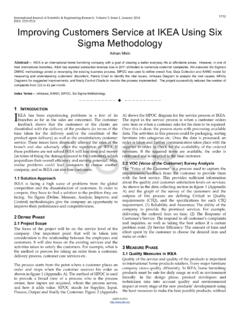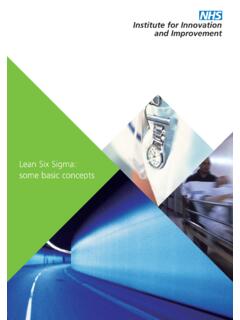Transcription of NHS Improvement An Overview of Six Sigma
1 NHS Improvement An Overview of Six Sigma October 2011 NHS Improvement , 3rd Floor, St Johns House, East Street, Leicester, LE1 6NB October 2011 What is Six Sigma ? Six Sigma is a continuous Improvement philosophy, methodology and toolkit that has a proven commercial pedigree that can be traced back to the quality revolution of the 1940 s. As a business strategy it focuses on the requirements of the customer and of improving processes, products and reducing costs. It enables organisations to improve performance by eliminating unnecessary processes and delays. As a methodology it provides a robust multistage framework with which to control Improvement efforts. This framework typically has the following stages; Define, Measure, Analyse, Improve and Control.
2 This is often referred to by its acronym . Six Sigma projects emphasise the importance of fully understanding customer needs and of the identification of problem root causes (rather than reacting to problem symptoms). Six Sigma projects concentrate on facts rather than management anecdote or opinion and most importantly ensure that Improvement is underpinned and sustained by rigorous statistical measurement and analysis. Six Sigma seeks to improve process performance, decrease variation and maintain consistent quality of the output of the process. It provides a disciplined data driven approach to quality and a method for eliminating defects. As a statistical concept, Sigma represents the amount of variation present in a process relative to customer requirements or specifications.
3 When a process operates at the six- Sigma level the variation is so small that the resulting products and services are defect free. (Equivalent to defects per million opportunities). Typically the ideas, concepts and the methodology that are Six Sigma are formally incorporated into the business and operational strategies of an organisation. This requires a substantial investment in training at all levels within the business . Once trained, different Improvement methodologies are available which can be aimed at either improving existing processes ( ) or in the design of brand new processes (Define, Research, Analyse, Define, Validate ). NHS Improvement , 3rd Floor, St Johns House, East Street, Leicester, LE1 6NB October 2011 The methodology The 5 step approach The five steps of the DMAIC method are as follows; 1) Define the project Define the project s purpose and scope.
4 Collect background information on the process and your customer s needs and requirements. 2) Measure the current situation Gather information on the current situation in order to provide a clearer focus for the Improvement effort. 3) Analyse to identify causes Identify the root causes of problems. Confirm them with data. 4) Improve Develop, improve and implement solutions that address root causes. Use data to evaluate results for the solutions and the plans to carry them out. 5) Control Maintain the gains by standardising work methods or processes. Anticipate future improvements and make plans to capture the lessons learned from the Improvement effort. The table below illustrates each stage of the process together with the types of activities the project teams will carry out.
5 Note that the tools and techniques listing is by way of example and is not exhaustive. NHS Improvement , 3rd Floor, St Johns House, East Street, Leicester, LE1 6NB October 2011 Step Purpose Main Activities Tools & Techniques Define Defines the problem, develops a clear mandate based on a real problem Identify Improvement opportunity Develop Charter Listen to Voice of the Customer Define critical customer requirements Map processes Charter Milestone plan Project plan Customer surveys Process maps Affinity diagrams Measure To understand the baseline and current levels of performance Identify measures Develop operational definitions Develop & implement measurement plan Collect other baseline information Detailed process mapping Measurement plan (existing versus new data)
6 Analyse To establish problem root causes and understand their effect on the process Identify root causes Validate root causes Determine true sources of variation Process control and capability Analysis of detailed process maps for Improvement opportunities Plot and analyse data Determine the amount of variation within processes Determine Sigma score Statistical process control Process capability calculations Defects per million calculations Fish bone diagrams X & Y analysis Cause & effect matrix 5 whys Pareto analysis Hot spot matrix, value/non value added analysis Histograms Improve To develop, select and implement the best solutions Generate solution ideas Evaluate & select solutions Develop process map for solution Initiate measure and evaluate pilot Communicate solutions to stakeholders and evaluate plan Process mapping Brain storming Chain letter/ideas box Affinity diagrams Force field analysis Solution screening PDSA/pilot studies NHS Improvement , 3rd Floor, St Johns House, East Street, Leicester, LE1 6NB October 2011 Control To ensure the solutions are embedded.
7 That the process has robust controls Verify reduction in variation and Sigma score Develop standard practices Monitor performance Integrate lessons learned Recommend future plans Identify next steps and remaining opportunities Control plan/dashboard Procedures and standards Process control systems Statistical process control On going training & education Relevance to the NHS and 18 weeks A study jointly conducted by the CHD Collaborative and the NHS Modernisation Agency over a two year period (and some 20 projects) identified that the strength of Six Sigma lay in the five stage DMAIC process which guides the Improvement process, together with rigorous statistical measurement, analysis and control that exists at the core of the methodology.
8 It was also recognised that the comprehensive nature of Six Sigma training provides an opportunity for Improvement practitioners (and project team members) to gain new skills and also to enhance and consolidate existing skills. These benefits provide the platform for the delivery of quantifiable service Improvement based on hard data (customer requirements, process performance, root cause analysis and so on) rather than soft management anecdote. A recent Six Sigma project conducted at Sherwood Forest NHS Trust with regard to outpatient department and diagnostic improvements has demonstrated the methodology s applicability to the 18 week outcomes. Set up correctly, Six Sigma projects will balance the process or output requirements of all customers (patients, clinicians, diagnostic technicians and so on) with the resources available to deliver that process or output both efficiently and effectively.
9 What makes for successful NHS Six Sigma projects? The study identified a number of areas in the application of the methodology that required refocusing together with a number of recommendations as to the required skill sets of the Six Sigma practitioners. 1) Skill sets In addition to full Six Sigma training practitioners must be competent in project planning, project leadership and team facilitation. Without these complementary skills, projects will fail as they are needed to support the DMAIC methodology. The tool kit is only a means to an end and not an end in itself. Of fundamental importance is the ability of the practitioner to use discretion in the application of the methodology and tools; most NHS problems will not need advanced statistical analysis or hypothesis testing to gain significant Improvement .
10 2) Application of the methodology Commercial Six Sigma projects are typically run within Six Sigma organisations whose business strategy has been created to support this methodology. This means that organisations will have NHS Improvement , 3rd Floor, St Johns House, East Street, Leicester, LE1 6NB October 2011 a Six Sigma trained workforce together with a board level mandate to pursue Improvement in order to gain competitive advantage. In short, Six Sigma will be part of the culture of the organisation. The NHS environment does not have this type of platform to conduct Improvement from. There is little in the way of coherent Improvement strategies and it suffers from competing priorities and limited resources.

















